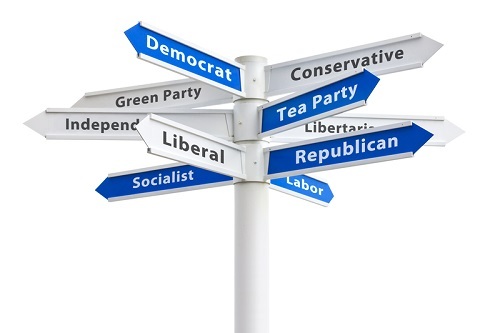

In a democratic government system, people are directly involved in decision-making. In your surroundings, you must have seen some groups, institutions, and organizations that have a common objective. Sometimes these groups, institutions, and organizations take initiative to resolve problems.
Political parties are also such a kind of social organization. But political parties are groups of people whose aim is complete elections to hold power. Sometimes some groups of people try to influence the decisions of the government by putting pressure on them, those are known as pressure groups. Bureaucracy is a type of organization formed to execute administrative tasks by coordinating systematically. Bureaucracy, political parties & pressure groups are essential components of democracy.
Power elite theory was given by sociologist C. Wright Mill.
He explains the distribution of power in the USA in his book titled ‘The power elite’.
According to him, the elite rule in society because of holding the key institutional position.
The three institutional elite's constituents are the corporation, the military & the federal government.
In American society, they solved important issues & matters & they skilfully controlled the masses through mass media & manipulation.
According to Max Weber, bureaucracy was a mode of organization premised on separating the public from the domestic world.
Bureaucratic authority signifies the following features:
Functioning of officials.
Hierarchical ordering of positions
Reliance on written documents.
Office management
Conduct in office
A pressure group is a group of individuals or organizations who attempt to influence policies & decisions of the government.
It is formed when people with common interests, aspirants, occupy the opinion of certain circumstances to achieve a certain objective.
They do not hold power, but they influence the people who have power by putting pressure on them.
Pressure groups can fulfil their demands through strikes, boycotts, letters, petitions, publicity campaigns & lobbying.
Some examples of pressure groups in India are All India Krishna Sabha (AIKS), Narmada Bachao Andolan (NBA), Confederation of Indian Industry (CII)
Pressure groups are classified into different categories as follows −
Pressure groups that are associated with political activities to influence public policies are known as primary pressure groups.
For example, organizations which are against corruption.
Pressure groups that are involved in non-political activity but rarely involved in political activities are known as secondary pressure groups.
A pressure group whose main aim is to protect the interest of members is called a sectional pressure group.
For example, the Confederation of Indian Industry (the CII), the main objective of which is to influence the government to adopt policies.
A pressure group whose main objective is not to protect the interest of members, but members of these groups should be taken into consideration.
The government regularly consults these groups.
Also, they have close access to government agencies & officials
These groups apart from the political loop are known as outsider groups.
Examples of these groups are Greenpeace, PETA
These are interest groups that are formed due to collective responses through riots, demonstrations & assassinations.
For example, terrorist organizations.

A group of people comes together to compete in elections, achieve power & establish the government of their party.
They have policies & world views. Also, they have a particular opinion about social issues.
These form the ideology of a political party.
Based on policies & ideology, they form agendas to achieve political power.
Political parties communicate with people and convey demands & complaints of people to the government.
The leaders, the active members & the followers are the main components of the political party.
Indian National Congress, Bhartiya Janta Party (BJP) and Communist Party of India (CIP) are some examples of national political parties.
The party should be independent & permanent.
The party should fulfil the requirements to be recognized as a political party.
A political party must be willing to appear in public.
A political party should secure seats in the assembly.
Consent elections.
Select a candidate for election.
They play an important role in making laws for the country.
If a political party won the election, they establish & runs the government.
If a political party loses an election, they act as an opposition party.
In this article, we have learned about the power elite, pressure groups, bureaucracy & political parties in brief
Power elite theory describes power relationships in modern society.
Bureaucracy, pressure & groups indirectly influence the political life of a society.
Pressure groups are an integral & crucial component of Indian democracy.
In India, there are many pressure groups formed based on different categories.
Political parties are a significant component of Indian democracy.
They act as a link between the people & government.
Also, we have learned the criteria for the identity of political parties & functions of political parties.
Q1. What are bureaucrats?
Ans. A person who is a member of the bureaucracy is known as a bureaucrat.
Q2. What are the main types of political parties in India?
Ans. National political parties & regional political parties are the two main types of political parties in India.
Q3. What is the difference between democracy & bureaucracy?
Ans. Democracy gives access to make the laws, whereas bureaucracy has the authority to implement the policies.